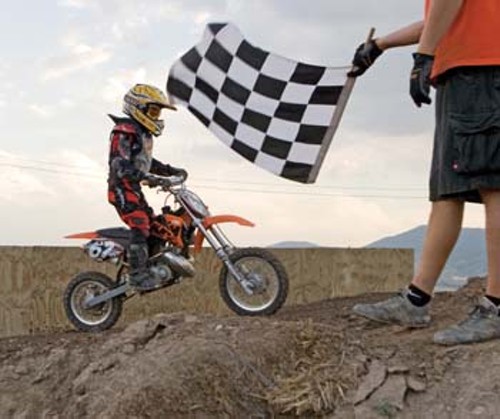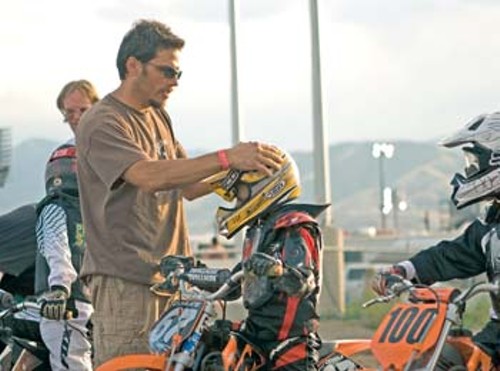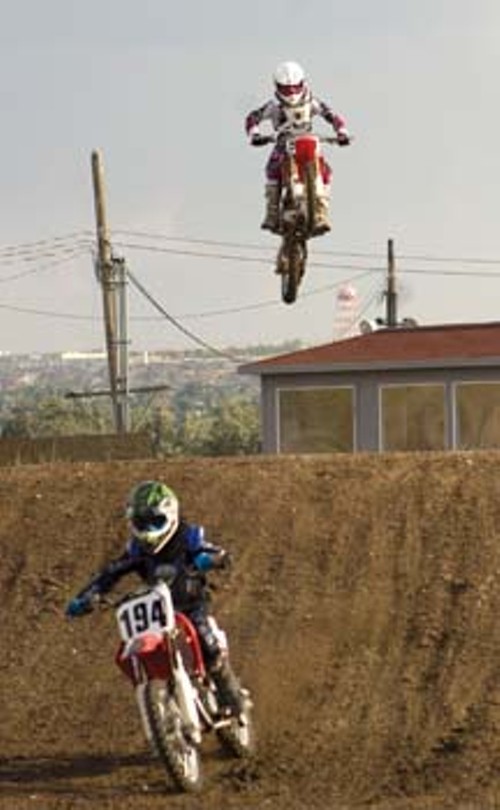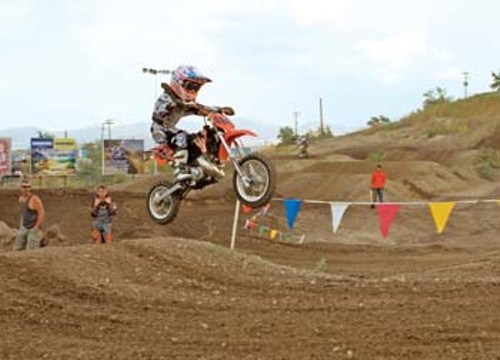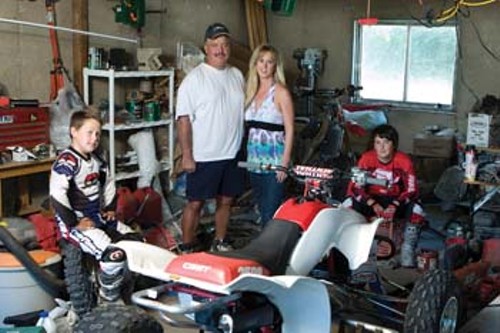Motocross as Child's Play
Young riders increasingly participate in the life-and-death jumps and crashes of the sport.
By Wren Abbott“I got wet,” Cheyenne, who is hyper with pre-race excitement, tells Austin Iverson, 12. A few minutes before, Austin had cooled himself off in the 95-degree weather the same way as Cheyenne, by chasing after one of the water-spraying trucks that continually patrol the grounds of Rocky Mountain Raceways to keep the dust down in the rows between racers’ trailers.
When the starting gates drop, the “powderpuff” girl riders take off on their tiny 65 cubic-centimeter motorcycles, whose engines’ whine is a comically high-pitched rendition of the bigger bikes’ rumbling. Right out of the starting gate, Cheyenne shoots ahead of the other riders in her class. The little riders do four laps around a modified version of the 6-acre track, skipping the upper loop that has bigger jumps for older riders.
“It’s so cute to watch the little kids that are going so slow go up and over the hill,” Austin Iverson’s mom, Dena, says, watching the powderpuff class as she waits for her younger son, Jake, to race. “They get to the top of the hill and take a look at Dad to make sure he’s still watching—that’s what [Jake] used to do.”
A volunteer flagger at the end of the track loop raises a checkered flag as Cheyenne buzzes by, winning her heat—which in motocross is called a “moto.” Austin, watching along the sidelines, admits he’s been beaten by a girl before.
“Actually, I think girls have as much natural talent to do this sport as boys do,” Austin’s dad, Demar, says. “They have a natural finesse—guys have a tendency to fight the bike, while girls just flow with it.”
After her first bike moto and her first ATV moto—Cheyenne also races ATVs—she is relaxing in the back of the utility trailer that hauls all her gear with her dad, Rod, her mom, Jody, and family friend Paul Housley, whose 11-year-old son Shayden is also there to compete. Rod and Jody are divorced but you’d never know—they both attend Cheyenne’s races (“They don’t fight,” Cheyenne precociously points out). Paul is divorced from Shayden’s mom, Deann, but she is also in attendance, sitting about 50 yards away with Shayden and a group of other little riders and their parents. The two families seem to exemplify almost to an extreme the motocross maxim that the family that races together stays together.
“It’s all about the kids,” says Rod, who doesn’t race himself but just serves as “mechanic and transport” for his daughter. “They start ’em out young—a lot of these kids have been racing since 3 or 4 years old.”
“Three,” Cheyenne chimes in boastfully, indicating the age she started.
“Tell her what else you do,” Jody prompts her daughter. “Karate and ride horses,” Cheyenne says. In her post-race outfit—a T-shirt and ruffled skirt, with her dark blonde hair in a neat braid, Cheyenne appears to be the sugar-and-spice alter-ego of the gung-ho motorcycle rider who just a few minutes before dominated her race (after two motos in the class, Cheyenne took first overall in powderpuff for the day).
A Strong Presence
The Craigs started racing because Rod’s brother-in-law’s son was into it, and when Cheyenne saw him compete, she wanted to try. Her 65cc bike is embellished with pink stickers on the fenders, and the frame of her racing ATV is painted purple, “so the boys know she’s a girl,” Rod says. The bike’s number plate bears her name and engine number (06) along with a small sticker that pays homage to another little rider who, in memory, remains a strong presence around the track. The sticker reads, “#81 Logan Emerson.”
Logan, who was Cheyenne’s age, died after crashing at a Friday-night race at Rocky Mountain Raceway exactly five weeks before the Pioneer Day event that Cheyenne, Shayden, Austin and Jake are now competing at. In a moto held around 1 a.m. at the end of a long-running night of races that began June 19, Logan overshot a tabletop jump at the bottom of a hill and went outside of the track bounds, hitting a wooden deflection wall. He died hours later of internal injuries at Primary Children’s Medical Center.
That jump has since been modified slightly, but not in response to Logan’s death; the track is constantly undergoing slight alterations, RMR spokesman Kevin Elzey said.
“The first thing that came to my mind was, ‘That’s it, my boys are done,’” Demar says. “But then two minutes later, I reconsidered.”
Logan
was riding the bigger of his two motorcycles, an 85cc, and was leading
the group of riders when he crashed. According to RMR point standings,
in the last seven days he raced, spanning an eight-week period, Logan
took first place in the 65cc 6-through-8-age group every time, first
place in the 65cc open-age group four times, and first in the 85cc
beginner class once, on May 31.
“My boy just bawled
when he found out,” Paul Housley said of Shayden, who was Logan’s
buddy. “He sat down on the porch and started crying—he said, ‘I don’t
know if I want to do this anymore.’”
Logan and Jake Iverson
were also close friends. The Iversons had attended the race the day
Logan died but left earlier in the night. The next morning, father
Demar Iverson went into South Valley Motorsports to pick up a part and
heard what happened. “The first thing that came to my mind was, ‘That’s
it, my boys are done,’” Demar says. “But then two minutes later, I
reconsidered.”
Nine-year-old Jake, whose spiky blond hair is a
partly grown-out Mohawk, took Logan’s death the hardest among the
Iversons. In an effort to shield their children from the tragedy, the
Iversons didn’t attend Logan’s funeral, and Jake was full of questions
about it. “He was always asking, ‘Do you think he’s in his [motocross]
gear?’” Dena said.
Jake seemed to make
some peace with what happened at a memorial held for Logan at RMR July
1, where the stickers and about 300 “In loving memory of Logan Emerson”
T-shirts were sold to pay for funeral costs. “With Jake being able to
go up to Logan’s dad, he realized that it was final and he was able to
share with him some of those times that they had,” Dena said. Still,
the first time after Logan’s death that Jake raced at RMR, he had a
hard time going down the hill to the jump where Logan crashed. He told
his mom he was going to take that hill slow.
“I told him, ‘No, you just go down it as you normally do,’” Dena said.
Brace Yourself
Judging from hundreds of comments posted by readers of The Salt Lake Tribune article
describing Logan’s death, the incident catapulted kids’ motocross onto
the mainstream radar and gave readers, some of whom had no direct
knowledge of the sport, license to condemn the Emersons and other
motocross parents as negligent or abusive.
Brad Frampton, who
raced on the national circuit until 1999 and has two sons—ages 10 and
12—who race, is one of two people in the motocross community
interviewed for this story who became so incensed by those comments
criticizing motocross parents that he shut off the computer.
“One
woman wrote, ‘I can’t believe that parents would strap their kids to a
motorcycle and send them out there for a cheap thrill,’” Frampton
fumes. “Somebody that doesn’t know anything about this sport doesn’t
have any right to judge it.”
The American Academy of
Pediatrics recommends that off-road motorcycling be restricted to
children over age 16, citing “immature judgment and motor skills” in
younger children. Under Utah state law, children over age 8 only may
ride off-road motorcycles on public land; there is no such restriction
for private land, such as motocross arenas.
According to data
collected by the Centers for Disease Control and Prevention, 245
Americans age 19 and under died in 2003 from offroad motorcycle
injuries, and 56,870 were treated in emergency rooms for offroad
motorcycling injuries. Twenty percent of the nonfatal injuries occurred
on motocross tracks, with 8.9 percent caused by a jump and 5.3 percent
from hitting another motorcycle or other vehicle. The injuries
represent 32.6 people per 100,000 of the population in that age range,
but no estimate is available of how many Americans in that age range
use off-road motorcycles, according to the CDC.
A dislocated hip and
punctured lung sustained in a motocross crash led Brad Frampton to quit
racing on a national level, he said. Before that, he broke a leg, as
his older son, Broc, did last year. Broc, a freckled kid with braces
wearing a Logan Emerson memorial shirt, didn’t even care about walking
after the injury—he just wanted to ride, his dad said.
Back at the Iversons’
trailer, where everyone is sitting on folding chairs under a tarp
rigged up to provide shade, Austin’s friend, Evan Crawford, 14, peels
down his racing pants to put on knee braces in preparation for his
first moto. Knee braces, which can prevent a break by keeping the joint
from moving laterally, aren’t part of the safety equipment required by
the American Motorcycle Association and therefore by RMR—helmet,
protective pants, long-sleeve jersey and boots. But last year, Evan was
practicing at RMR when he landed a jump, did an “endo” or “digger”—a
forward flip—and got run over by another rider. He broke his leg, and
now he’s wearing the braces to protect himself in the event of another
crash.
Demar Iverson usually races in the over-40 class, but
this year he’s sidelined with a knee injury. During 27 years of racing,
Demar has also dislocated his shoulder, torn his anterior cruciate
ligament, broken his wrist and broken his collarbone. Ellie Murphy, 13,
who took third in her ATV class on Pioneer Day, flipped off her ATV
last year and landed on her hands, breaking both her wrists. She was
back on the machine as soon as she got her casts off, though it took
four or five races before she was back to her previous speed, her dad
Mark says. As Ellie, Shayden, and a few other little riders horse
around in a circle behind the adults, trying to spray each other with
water, Mark remembers that the group of kids is one short.
“Logan would be out here playing,” Mark says.
Getting Your G.O.A.T.
One thing critics of
kids’ motocross probably don’t realize is that most professional
motocross and supercross (more technical wintertime dirt-bike racing,
done in indoor arenas) riders began racing no later than age 4,
according to RMR motocross manager Curt Stewart. “James Stewart, the
reigning supercross champion, started when he was 4 years old,” Curt
Stewart says. “It’s a young man’s sport— you have champions retiring
when they’re 26, 27 years old.”
North Salt Lake’s SLMX
motocross complex director Robin Williams says if riders don’t have a
sponsor providing them with gear by the time they’re 11, the chances of
them getting a national sponsor are nil.
Ricky Carmichael, dubbed the “all-time winningest racer in AMA history” by motocross.com, started racing at age 3 and retired at 27 after winning 15 national championships. Sports Illustrated estimated his 2005 income as between $8 million and $10 million, including his salary from Suzuki and championship bonuses. Carmichael, often called G.O.A.T. or “greatest of all time” is Austin Iverson and Broc Frampton’s idol—both boys would eventually like to turn pro.
“We hope for it, but
don’t push it,” mom Dena Iverson says. “I think whatever they do, I’d
like to see them go as far as they can. But we leave it up to them.”
The
pro-motocross riders Peyton Smith idolizes dominate the décor on his
bedroom walls—in the form of “fatheads” or life-size stickers. “You
would die if you saw his room,” his mother, Robin Smith, says. Peyton,
7, got his first motorcycle when he was 3. The family lives on four
acres in Syracuse, so Peyton has his own motocross practice track.
“It’s a spendy sport, but we also have horses—whatever you’re into’s
expensive,” Robin points out.
The Iversons estimate
they spent about $15,000 in 2008 on motocross. A race-ready 50cc that a
child outgrows in a few years costs between $3,500 and $4,000,
according to Austin Boyd of Full Throttle Powersports in Centerville,
which outfits many of the area’s little riders. Safety equipment like
helmets and boots vary widely in price; the average parent spends
between $400 and $500 on safety gear, Boyd said. Participating in a
race at RMR costs $35 for the first moto and $25 for each additional
moto, for a minimum cost of $60. A day of practice at RMR costs $15.
Most children are
sponsored by Full Throttle or another dealer, but it’s a buy-in
sponsorship that basically serves as an incentive to choose a
particular store. At Full Throttle, parents get a package of free
practice days at SLMX and reduced price on gear and mechanic service
after buying a bike.
An additional cost some
families take on is oneon-one coaching provided by a motocross trainer.
On a Saturday morning at SLMX, a trainer is coaching Nicholas Garza,
10, trying to get him to go over a jump called a step-up. The 14-acre
course, with a variety of doubles, triples, tabletops and step-ups is
more technical—more like a supercross track—than the RMR track,
according to complex director Robin Williams’ husband Ben, who does the
track maintenance and grooming.
At SLMX, riders at all levels
do the whole course, Robin Williams says. Riders approach the step-up
going uphill and have to get over a lip before coming down the other
side. It’s a little eerie, Nicholas Garza’s dad, Steve, says, because
they can’t see what they’re going to go down.
Despite its family appeal, motocross is not for everyone. Nicholas is out in near-100 degree weather on a weekend working on that challenging jump, but Nicholas’ five siblings don’t race—one of his brothers attempted the sport but, when he fell into a puddle on a muddy track, he walked away from the bike. And that was it, his dad says.
Making the Grade
To practice reading
terrain—finding the fastest lines in the contours of the land—Austin
and Jake go riding out in the west desert. During a race, wheeldeep
ruts form in the track’s fastest lines, and skilled riders are almost
horizontal as they make sharp turns, their tires gripping the walls of
the ruts. Riders learn to “scrub,” or turn the bike sideways when
they’re in the air over jumps—a technique to keep the bike low, to land
quicker in the interest of speed.
As riders get competitive,
they’ll attempt to “high side” the competition, or push them up into
the edge of a track during a race. Watching the pro riders compete on
the RMR course on their imposing 250F machines, the spectator sees the
frontrunners sail over the “grandstand” jump, the highest at RMR while,
simultaneously behind them, the motion of the later riders forms a
background counterpoint as one after another launches into view,
tackling the tabletop.
Evan
Crawford says motocross is the most physically demanding sport after
soccer—a seemingly dubious claim, considering the kids are riding
motorized vehicles. But Evan is referring to a 1980 study done at the
National Sport Health Institute in Englewood, Calif., that tested the
physical fitness of nine motocross riders and compared them to pro
athletes in other sports. According to an interview published in a
Canadian motocross magazine with one of the test subjects, Motocross
Grand Prix World Champion Brad Lackey, the scientists didn’t expect to
be wowed by the motocross riders—they lacked well-defined muscles and,
in the case of Lackey, had as much as 22 percent body fat because it
was the off season. But the testing determined the riders had the
strength of gymnasts and the cardiovascular conditioning of marathon
runners. Only soccer players scored higher.
The opportunity
motocross provides parents to promote athleticism and good nutrition in
their kids is one thing several praised about the sport—though typical
kids’ snack food like Cheetos and Skittles seemed to predominate around
the race tracks. Many parents also said they use motocross as a carrot
to get their kids motivated in school. “If they don’t do what they’re
supposed to do, they don’t get to ride—and that’s good leverage,” Brad
Frampton says. “So far, we’ve gotten straight As out of both my kids.”
Parents hardly need to point out the No. 1 benefit of the sport: Motocross families spend a lot of time together. Whatever criticisms might be made of motocross parents, it’s impossible to accuse them of not being involved with their kids’ lives or of not devoting enough time to their kids’ passions. In an average day of racing, most kids ride in two motos, each of which lasts around 15 minutes, depending on the course and rider’s level. All of the classes, from pee-wee age 4 through 6 to over-age-30 pro, are run through one time, which takes about three hours. After an intermission, the order begins again, and riders wait for their turn to come around a second time. ...the testing determined the riders had the strength of gymnasts and the cardiovascular conditioning of marathon runners. Only soccer players scored higher.
In the meantime, there are hours of time to just to hang around. Some
parents, like Mark Murphy, do this all Friday night, then go home, get up the next
day and head off to a Saturday- Sunday race event like those held at
SLMX. Most people bring their fifth wheels to those events, set up as
early as Friday night, and they spend the evenings sitting around the
campfire while the kids roast marshmallows. Motocross parents’ friends
are other motocross parents. Many of them describe the motocross
community as one big extended family.
“When
he first started out, he’d go down in a corner and four different
fathers would go after him,” Don Nicholas said of his son, Skylar, now
17, who started racing 10 years ago. Now that Skylar is at the age
where kids can really give parents something to worry about, Don and
his wife Ella take comfort in the fact that they usually know where he
is and who he’s with. He’s been riding with the same group of kids
since he was little. He tends to slow down in the turns and
that’s what kills him,” Jason says. “I loosened up the brakes so he
doesn’t use them as much.”
We Like the Adrenaline Rush “
I
can’t say that a lot of people have 18 and 21-yearolds that want to
hang out with their parents still,” says SLMX’s Robin Williams,
referring to her boys, Rudy and Benny, who both race at the national
level. SLMX only opened last year and didn’t begin hosting races until
this April, but motocross has been a lifelong passion for their whole
family. When Benny was 4, he and his dad went to watch a motocross
race. Afterwards, says Robin, “It was, ‘Mom, I can do that. I need a
dirt bike.’”
Robin
remembers Benny’s first race in Preston, Idaho, “like it was
yesterday.” Benny got first place overall for his class. “It was like,
‘Wow, this kid can ride,’” Robin says. By the time Rudy was 3, he was
determined to follow his older brother into the sport. Robin still
remembers how she and Ben told Rudy that they would get him a
motorcycle as soon as he could ride a bicycle without training wheels.
By the next morning, he could.
“My kids will always be that
age to me,” Robin says, getting nostalgic. “Maybe I was just young when
my kids got started, but the more they got involved in it and the
better they did, the more we all liked it. You know how there’s just
certain things you truly, truly enjoy, clear down in your heart? That’s
how it is for me.”
Brandston
Albright, 4, didn’t even have to learn to balance on a two-wheeled
bicycle before he got his own tiny 50cc, with obtrusive training wheels
that he’ll have to learn to ride without before he can race. Dad Jason
Albright, a sunburned blond wearing racing pants, boots and no shirt
who himself began racing when he was 5, is coaching Brandston and his
older son, Jake, 7, on the SLMX track.
“We like the adrenaline
rush, huh, Jake?” Jason asks his son. Jake Albright smiles as he eases
his helmet onto his head. “Yeah,” he says shyly. “I don’t even know how
to explain it—it’s almost like you’re getting ready to jump out of a
plane,” Jason says of starting-line jitters.
Jake starts his
65cc bike up himself and putters over to the track as Jason follows
him, inexplicably leaving Brandston unsupervised at the truck. Clods of
mud fly off Jake’s tires as he careens past his dad, who is leaning
over into the track, forming his right hand into a C shape. He says
that signal means full throttle. “He tends to slow down in the turns
and that’s what kills him,” Jason says. “I loosened up the brakes so he
doesn’t use them as much.”
Jason
mentions that his ex-wife, Jake’s mom, doesn’t approve of motocross.
“She doesn’t like him doing it, but it’s our dream; it’s what we like
to do,” Jason says. “We’re lifers.”
More by Wren Abbott
-
Radio Silence
After a long quiet year, Park City public- radio magnate Blair Feulner phones home.
- Jul 15, 2009
- More »
Latest in Cover Story
Readers also liked…
-
Forget the family pedigree—Robert F. Kennedy Jr should not be the next president of the United States
Trojan Horse
- Jun 21, 2023
-
Women decry harassment and toxic culture at St. George auto dealership
Men at Work
- Oct 11, 2023



